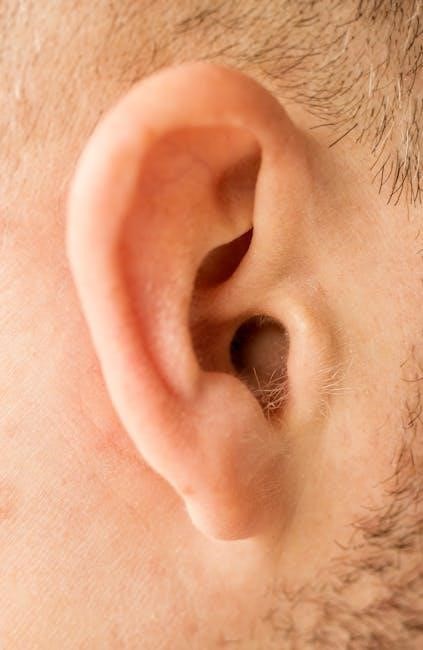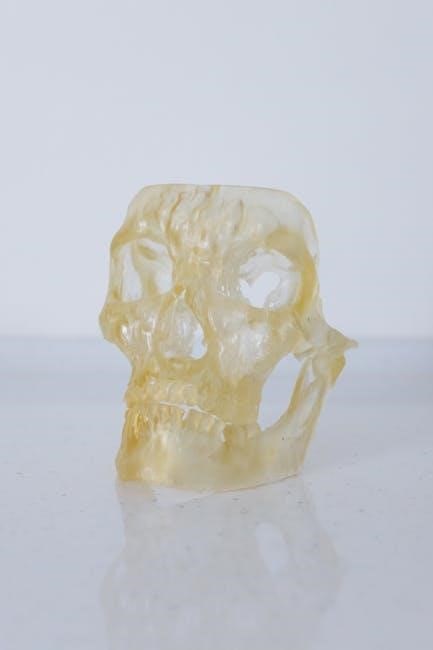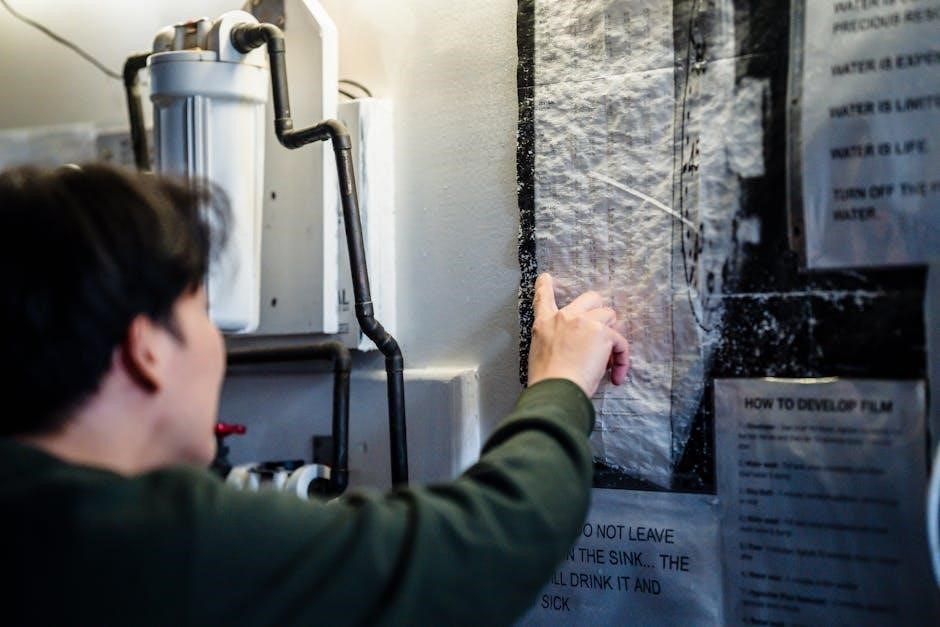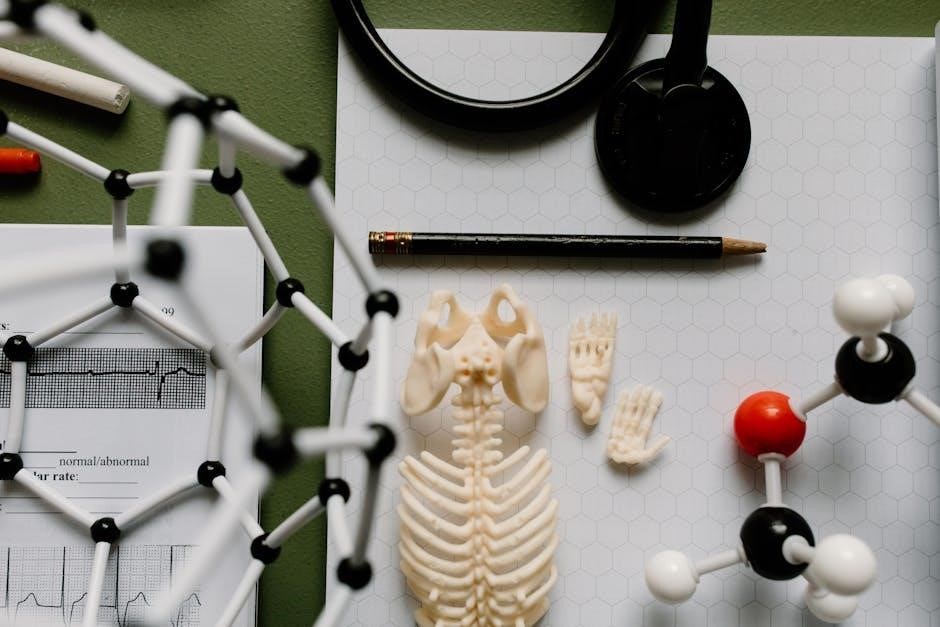Welcome to your comprehensive study guide for Human Anatomy and Physiology! This guide offers interactive flashcards, quizzes, and detailed insights to help you master body organization, chemistry, cells, tissues, and systems effectively.
1.1 Overview of the Importance of Anatomy and Physiology
Anatomy and Physiology are foundational sciences that explore the structure and function of the human body. Understanding these fields is crucial for healthcare professionals, as they provide insights into how the body operates under normal and pathological conditions. Anatomy focuses on the physical organization of body parts, while Physiology delves into the processes that sustain life, such as circulation, digestion, and nerve signaling. Together, they explain how the body maintains homeostasis and adapts to changes. Studying these subjects is essential for careers in medicine, nursing, and allied health, as well as for understanding the basis of nutrition, exercise, and disease prevention. They form the cornerstone of human health and wellness.
1.2 Key Concepts and Terminology
Mastering key concepts and terminology is essential for understanding anatomy and physiology. Fundamental terms include levels of organization, homeostasis, and anatomical directions. Concepts like cells, tissues, and systems form the basis of studying the human body. Terms such as proximal and distal describe locations, while flexion and extension explain movements. Understanding processes like cellular respiration and neural signaling is crucial. Familiarity with terms like skeletal, muscular, and nervous systems aids in navigating complex topics. Grasping these concepts and terms provides a solid foundation for advanced study and practical applications in healthcare and science.
1.3 How to Use This Study Guide Effectively
To maximize your learning, start by setting clear goals and breaking topics into manageable sections. Use the interactive flashcards and quizzes to reinforce key concepts. Review diagrams and label them to enhance visual learning. Engage in active learning by summarizing notes in your own words and teaching concepts to others. Practice regularly, focusing on weak areas identified through self-assessment. Utilize the pacing guide to stay on track and allocate time for review. Supplement your study with recommended tools and resources, such as online tutorials and practice exams. By following these strategies, you can efficiently master anatomy and physiology, ensuring a strong foundation for academic and professional success.

Fundamental Concepts of the Human Body
Explore the basic principles of human anatomy and physiology, including body organization, chemical composition, and cellular functions. Understand how these elements interact to maintain life and health.
2.1 Levels of Organization in the Human Body
The human body is organized into a hierarchical structure, starting from the simplest to the most complex. The levels include cells, tissues, organs, organ systems, and the entire organism. Cells are the basic units of life, forming tissues through specialization. Tissues combine to create organs, which perform specific functions. Organs work together in systems, such as the nervous or digestive system, to maintain overall health. Understanding these levels is crucial for grasping how the body functions as an integrated whole. This framework helps in studying anatomy and physiology, enabling a systematic approach to learning about the body’s structure and processes.
2.2 Body Systems and Their Interactions
The human body is composed of 11 major systems that work together to maintain overall health. These systems include the skeletal, muscular, nervous, circulatory, respiratory, digestive, urinary, endocrine, integumentary, immune, and reproductive systems. Each system has distinct functions, but they are deeply interconnected. For example, the circulatory system transports oxygen and nutrients to cells, while the respiratory system provides oxygen. The nervous system controls voluntary and involuntary actions, and the endocrine system regulates hormones. Understanding how these systems interact is essential for comprehending how the body functions as a whole. This integration ensures processes like movement, digestion, and neural control occur seamlessly, maintaining homeostasis and enabling life.
2.3 Homeostasis and Its Significance
Homeostasis is the body’s ability to maintain a stable internal environment despite external changes. It ensures optimal conditions for cellular functions, such as regulating temperature, pH, and blood glucose levels. This balance is achieved through feedback mechanisms, where the body monitors and adjusts its processes. For example, when blood sugar rises, insulin is released to lower it, and when it drops, glucagon increases it. Homeostasis is crucial for overall health, as it enables the body to function efficiently and respond to stress. Without it, cellular activities would be disrupted, leading to disease or even death. Understanding homeostasis is key to grasping how the body maintains its intricate physiological processes.

Body Chemistry and Biochemistry
Body chemistry explores the building blocks of life, including atoms, molecules, and chemical bonds. It delves into the role of water, pH balance, and essential nutrients for bodily functions.
3.1 Atoms, Molecules, and Chemical Bonds
Atoms are the basic building blocks of matter, consisting of protons, neutrons, and electrons. In the human body, atoms combine to form molecules through chemical bonds, such as covalent, ionic, and hydrogen bonds. These interactions are essential for forming biological molecules like water, proteins, and DNA. Understanding the structure and properties of atoms and molecules is crucial for grasping how the body functions at a cellular and systemic level. This section explores the fundamental chemistry underlying human physiology, providing a foundation for studying complex processes like metabolism and homeostasis. Mastering these concepts is vital for success in anatomy and physiology.
3.2 The Role of Water and pH Balance in the Body
Water is the most abundant substance in the human body, serving as a medium for chemical reactions, transporting nutrients, and maintaining cellular structure. It plays a critical role in regulating body temperature and lubricating joints. pH balance is essential for proper bodily functions, as enzymes and proteins require a specific pH range to function effectively. The body maintains homeostasis through buffers like bicarbonate, which regulate acidity. Imbalances in pH can lead to conditions such as acidosis or alkalosis, highlighting the importance of this equilibrium. Understanding water and pH balance is fundamental for grasping how the body maintains its internal environment and overall health.
3.3 Essential Nutrients and Their Functions
Essential nutrients are vital for maintaining proper bodily functions, growth, and overall health. They include carbohydrates, proteins, fats, vitamins, minerals, and water. Carbohydrates provide energy, while proteins build and repair tissues. Fats are crucial for cell membrane structure and hormone production. Vitamins and minerals act as cofactors for enzymes, supporting processes like metabolism and immune function. Water, though not a nutrient, is essential for hydration and cellular activities. A deficiency in any of these can lead to health disorders, emphasizing the importance of a balanced diet. Understanding their roles helps in appreciating how nutrients sustain life and maintain homeostasis in the human body.

Cells and Their Functions
Cells are the basic units of life, responsible for growth, reproduction, and metabolism. They maintain homeostasis through specialized functions, adapting to meet the body’s needs efficiently.
4.1 Structure and Components of Cells
Cells are the basic units of life, consisting of a cell membrane, cytoplasm, and nucleus. The cell membrane regulates material exchange, while cytoplasm contains organelles like mitochondria, the energy producers. The nucleus houses DNA, controlling cell activities. Other key components include the endoplasmic reticulum, which processes proteins, and ribosomes, responsible for protein synthesis. Lysosomes contain digestive enzymes, and the cytoskeleton provides structural support. Each part works together to maintain cellular function and overall health.
4.2 Cellular Transport and Communication
Cellular transport involves the movement of materials across cell membranes, essential for survival. Passive transport, including diffusion and osmosis, relies on concentration gradients and requires no energy. Active transport moves substances against gradients, using energy from ATP. Vesicular transport involves vesicles for larger molecules. Communication occurs through signals, such as hormones or neurotransmitters, which bind to receptors, triggering responses. Cells also communicate via direct contact, like gap junctions, allowing ion and small molecule exchange. These processes ensure proper cellular function, coordination, and overall organismal health, maintaining homeostasis and enabling responses to stimuli.
4.3 Cell Division and Growth
Cell division is essential for growth, repair, and reproduction. Mitosis and cytokinesis ensure genetic continuity, producing two identical daughter cells. The process includes prophase (chromosome condensation), metaphase (alignment), anaphase (separation), and telophase (reformation of nuclei). Interphase precedes division, involving DNA replication and protein synthesis. Cell growth is regulated by hormones and growth factors, ensuring proper size and function. Abnormal cell division can lead to disorders like cancer. Understanding these processes is vital for grasping tissue repair, immune responses, and development. This section explores the mechanisms and significance of cell division and growth in maintaining human physiology and health.

Tissues: The Building Blocks of Organs
Tissues are groups of specialized cells that work together to perform specific functions. They form the structural and functional basis of organs, enabling bodily systems to operate effectively.
5.1 Types of Tissues and Their Functions
Tissues are groups of specialized cells that work together to perform specific functions. There are four primary types of tissues in the human body: epithelial, connective, muscle, and nervous tissue. Epithelial tissue forms linings and coverings, such as the skin and mucous membranes, protecting the body and regulating exchange with the environment. Connective tissue, including bone, cartilage, and blood, provides support, structure, and connectivity to organs and systems. Muscle tissue is responsible for movement, while nervous tissue facilitates communication through nerve impulses. Each tissue type plays a vital role in maintaining the body’s overall function and health, enabling organs to operate effectively.
5.2 Epithelial Tissue: Structure and Function
Epithelial tissue forms the lining or covering for most body surfaces, both externally and internally. It is composed of tightly packed cells that form a continuous layer, providing protection, regulation, and secretion. This tissue is found in the skin, mucous membranes, and glandular structures. Epithelial cells are specialized for functions such as absorption, filtration, and secretion, depending on their location. For example, the epithelial lining of the intestines aids in nutrient absorption, while the skin’s epithelial layer protects against external pathogens. Its ability to regenerate makes it crucial for maintaining barrier functions and overall bodily health. This tissue is essential for safeguarding and facilitating the body’s interactions with its environment.
5.3 Connective Tissue: Types and Roles
Connective tissue is one of the most abundant tissues in the body, providing support, structure, and connectivity to various organs and systems. It is characterized by its ability to bind other tissues and organs together. The main types include bone, cartilage, adipose, and blood. Bone tissue provides strength and protection, while cartilage offers cushioning and flexibility. Adipose tissue stores energy and insulates the body. Blood, a liquid connective tissue, transports nutrients, oxygen, and waste products. Connective tissue also plays a role in immune responses and repair processes. Its unique composition, including a matrix of cells, fibers, and ground substance, allows it to perform diverse functions essential for maintaining overall bodily integrity and function.

The Integumentary System
The integumentary system, comprising skin, hair, nails, and glands, protects the body, regulates temperature, and aids in sensation, playing a vital role in overall health and function.
6.1 Structure and Function of the Skin
The skin, the body’s largest organ, consists of multiple layers, with the epidermis being the outermost layer and the dermis beneath it containing blood vessels, nerve endings, and glands. It protects against external damage, regulates body temperature, and aids in sensation through sensory receptors. The skin also plays a role in water and electrolyte balance and helps produce vitamin D. Its structure includes keratinocytes, melanocytes, and Langerhans cells, each serving unique functions. Understanding the skin’s anatomy is crucial for grasping its role in maintaining homeostasis and overall health.
6.2 Accessory Structures: Hair, Nails, and Glands
Hair, nails, and glands are essential accessory structures of the integumentary system. Hair provides protection, aids in sensory perception, and regulates body temperature. Nails act as protective coverings for the tips of fingers and toes, while also serving as tools for grasping and manipulating objects. Sweat and sebaceous glands produce secretions that regulate body temperature and maintain skin health. These structures work together to enhance the skin’s protective and regulatory functions, ensuring overall bodily homeostasis and well-being.
6.3 Protective Functions of the Integumentary System
The integumentary system serves as the body’s first line of defense, protecting against external threats like pathogens, UV radiation, and physical damage. The skin acts as a physical barrier, preventing the entry of harmful microorganisms. Its tight junctions and lipid layers also minimize water loss, maintaining proper hydration and thermoregulation. Additionally, the skin houses immune cells, such as Langerhans cells, which detect and combat pathogens. Sensory receptors in the skin detect pain, pressure, and temperature, alerting the body to potential dangers; The skin also produces antimicrobial substances, further enhancing its protective role. Together, these functions safeguard the body, maintaining homeostasis and overall health.

The Skeletal System
The skeletal system, comprising bones, cartilage, and ligaments, provides structural support, protects organs, facilitates movement, produces blood cells, and stores minerals. It interacts with muscles and nerves to enable bodily functions and maintain posture.
7.1 Structure and Function of Bones
Bones are rigid, calcified tissues forming the skeleton’s framework. Their structure includes the periosteum (outer layer), cortex (dense outer shell), trabeculae (spongy inner bone), and medullary cavity (central hollow space).
Bones serve multiple functions: providing structural support, protecting internal organs (e.g., skull for the brain), facilitating movement via joints, producing blood cells in marrow, and storing minerals like calcium and phosphorus.
Their unique composition of organic collagen and inorganic hydroxyapatite allows bones to be both strong and flexible. Understanding bone anatomy is crucial for grasping skeletal system dynamics and human physiology.
7.2 Axial and Appendicular Skeleton
The human skeleton is divided into two main systems: the axial and appendicular. The axial skeleton includes the skull, vertebral column, ribs, and sternum, forming the body’s central axis and protecting vital organs like the brain and heart.
The appendicular skeleton comprises the upper and lower limbs, shoulders, hips, and pelvic girdle, enabling movement and supporting the body’s appendages. Together, these systems provide structural support, facilitate movement, and protect internal organs, illustrating the skeleton’s dual role in stability and mobility. Understanding their functions and interactions is essential for grasping human anatomy and physiology.
7.3 Joints and Their Classification
Joints, or articulations, are points where bones meet, enabling movement and providing stability. They are classified based on their structure and function. Fibrous joints, like the sutures in the skull, are immovable and held together by dense connective tissue.
Cartilaginous joints, such as the pubic symphysis, allow limited movement and are connected by cartilage. Synovial joints, the most common type, are highly movable and characterized by a synovial cavity filled with fluid for lubrication. Examples include the shoulder, elbow, and knee. Joints are essential for locomotion, and their classification helps in understanding human mobility and the skeletal system’s functionality. This knowledge is crucial for studying anatomy and physiology, as it explains how bones interact to facilitate movement and maintain structural integrity.

The Muscular System
The muscular system comprises skeletal, smooth, and cardiac muscles, each with unique roles in movement, stability, and internal functions, essential for overall bodily operations and health.
8.1 Types of Muscles and Their Functions
The human body contains three primary types of muscles: skeletal, smooth, and cardiac. Skeletal muscles are voluntary muscles attached to bones, enabling movement and posture. Smooth muscles are involuntary, found in internal organs like the digestive tract, facilitating functions such as peristalsis. Cardiac muscle is specialized for the heart, ensuring continuous, rhythmic contractions to pump blood. Each muscle type has distinct structures and roles, working together to maintain bodily functions and mobility. Understanding their functions is crucial for grasping how the muscular system contributes to overall health and movement.
8.2 Muscle Structure and Physiology
Muscles are composed of long, multinucleated fibers wrapped in a plasma membrane called the sarcolemma. Inside, myofibrils contain sarcomeres, the functional units of contraction. The sliding filament theory explains how actin and myosin filaments interact to produce movement. Muscle physiology relies on neuromuscular junctions, where nerve impulses trigger calcium release from the sarcoplasmic reticulum, initiating contractions. Energy for muscle activity is supplied by ATP, with glycolysis and oxidative phosphorylation providing additional energy during prolonged use. Proper muscle function is essential for movement, posture, and internal processes like digestion and blood circulation.
8.3 Muscle Disorders and Injuries
Muscle disorders and injuries can significantly impact movement and overall health. Common conditions include muscle strains, tendinitis, and tears, often caused by overstretching, direct blows, or repetitive stress. Symptoms may include pain, swelling, and limited mobility. Muscular dystrophy is a genetic disorder leading to progressive muscle weakness and degeneration. Injuries like pulls or ruptures require rest, ice, and physical therapy for recovery. Proper treatment and rehabilitation are crucial to restore function and prevent further damage. Understanding these conditions helps in adopting preventive measures, such as proper warm-ups and ergonomic practices, to maintain muscle health and avoid long-term complications.

The Nervous System
The nervous system is a complex network controlling body functions, enabling communication, and coordinating responses. It includes the brain, spinal cord, and nerves, essential for sensory input, motor output, and maintaining homeostasis.
9.1 Structure and Function of Neurons
Neurons, or nerve cells, are specialized cells designed to transmit information through electrical and chemical signals. They consist of dendrites, a cell body, and an axon. Dendrites receive signals, while the axon transmits them to other neurons or target cells. The cell body contains the nucleus and organelles essential for cell function. Neurons communicate via synapses, where chemical neurotransmitters are released and bind to receptors. This process enables the nervous system to control voluntary and involuntary actions, such as movement, sensation, and regulation of bodily functions. Understanding neuron structure and function is crucial for grasping how the nervous system operates and maintains homeostasis.
9.2 The Brain and Spinal Cord
The brain and spinal cord form the central nervous system (CNS), serving as the control center for the body. The brain consists of the cerebrum, cerebellum, and brainstem, each with distinct functions. The cerebrum manages thought, emotion, and voluntary movements, while the cerebellum coordinates balance and motor skills. The brainstem regulates vital functions like breathing and heart rate. The spinal cord connects the brain to the body, facilitating reflexes and transmitting nerve impulses. Both structures are protected by the meninges and cerebrospinal fluid, ensuring their integrity. Together, the brain and spinal cord enable complex functions, from cognition to automatic responses, maintaining homeostasis and overall bodily control.
9.3 Reflexes and Nerve Impulses
Reflexes are automatic, rapid responses to stimuli, involving the central nervous system. They occur without conscious thought, such as withdrawing a hand from heat. Nerve impulses, or action potentials, transmit signals through neurons. These impulses are generated by ion exchanges across cell membranes, creating electrical and chemical signals. The process begins with stimulation, followed by depolarization, where sodium ions enter the cell, and repolarization, where potassium ions exit. This cycle allows nerve impulses to propagate, enabling communication within the nervous system. Reflexes and nerve impulses are crucial for maintaining homeostasis and responding to environmental changes, ensuring the body functions efficiently and adaptively.

Study Tips and Resources
Utilize interactive flashcards, quizzes, and digital guides to enhance learning. Engage with diagrams, videos, and practice questions to reinforce concepts effectively in anatomy and physiology studies.
10.1 Effective Study Strategies for Anatomy and Physiology
To excel in anatomy and physiology, adopt active learning techniques such as labeling diagrams and engaging in group discussions. Use flashcards to memorize complex terminology and concepts. Practice with online quizzes and interactive tools to reinforce understanding. Review notes regularly and teach concepts to others to deepen your knowledge. Utilize visual aids like videos and 3D models to better grasp spatial relationships. Set a consistent study schedule and prioritize challenging topics. Apply concepts to real-life scenarios to enhance retention. Seek clarification on difficult subjects from instructors or study groups. Combine theoretical knowledge with practical applications to build a strong foundation in anatomy and physiology.
10.2 Recommended Study Tools and Resources
Enhance your learning with these recommended study tools and resources. Utilize digital guides featuring interactive flashcards and quizzes for engaging practice. Explore anatomy diagrams and 3D models to visualize complex structures. Take advantage of online platforms like Nurse Cheung Store for comprehensive practice questions and study guides. Watch educational videos, such as those from Crash Course, to supplement your textbook learning. Use flashcard apps to memorize terminology and concepts efficiently. Access pacing guides and essential questions to stay organized and focused. Leverage notebooks and rubrics to track your progress and understanding. Combine these tools to create a well-rounded study routine that supports your success in anatomy and physiology.
10.3 Practice Questions and Quizzes
Practice questions and quizzes are essential for reinforcing your understanding of anatomy and physiology. Utilize resources like ATI TEAS 7 Complete Study Guides, which offer comprehensive practice questions to test your knowledge. Digital flashcards and interactive quizzes provide engaging ways to review terminology and concepts. Regularly taking quizzes helps identify areas needing improvement and builds exam confidence. Simulate real-test conditions to enhance time management and reduce anxiety. Track your progress to monitor growth and focus on weak areas. Consistent practice ensures mastery of complex topics, making you well-prepared for assessments and future applications in healthcare and science fields.
